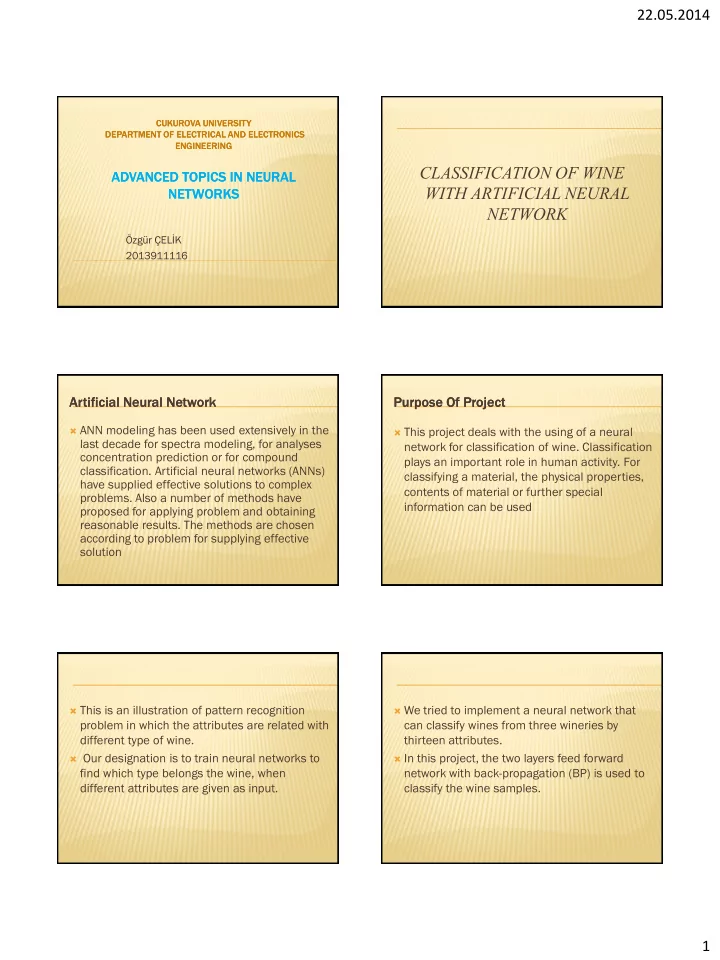

22.05.2014 CUKUROVA CUKUROVA UNIVERSITY UNIVERSITY DEPARTMENT DEPARTMENT OF OF ELECTRICAL ELECTRICAL AND AND ELECTRONICS ELECTRONICS ENGINEERING ENGINEERING CLASSIFICATION OF WINE ADVANCED TOPICS IN NEURAL ADVANCED TOPICS IN NEURAL WITH ARTIFICIAL NEURAL NETWORKS NETWORKS NETWORK Özgür ÇELİK 2013911116 Artificial Artificial Neural Neural Network Network Purpose Purpose Of Project Of Project ANN modeling has been used extensively in the This project deals with the using of a neural last decade for spectra modeling, for analyses network for classification of wine. Classification concentration prediction or for compound plays an important role in human activity. For classification. Artificial neural networks (ANNs) classifying a material, the physical properties, have supplied effective solutions to complex contents of material or further special problems. Also a number of methods have information can be used proposed for applying problem and obtaining reasonable results. The methods are chosen according to problem for supplying effective solution This is an illustration of pattern recognition We tried to implement a neural network that problem in which the attributes are related with can classify wines from three wineries by different type of wine. thirteen attributes. Our designation is to train neural networks to In this project, the two layers feed forward find which type belongs the wine, when network with back-propagation (BP) is used to different attributes are given as input. classify the wine samples. 1
22.05.2014 Two Layer Feed Forward Network With Sigmoid Two Layer Feed Forward Network With Sigmoid Learning Learning Technique Technique Hidden And Output Layer Hidden And Output Layer We will use supervised learning technique and multilayer feed forward network for implementation of project. Algorithms Algorithms Implementation Implementation of of Neural Neural Network Network by by Using Using Nnftool Nnftool Two types of algorithms will be used in our project; 1) 1)Lev even enbe berg rg – Marqu rquardt Algorithm 2) 2)Scaled Conjuga gate Gradien ent Algorithm In these methods, the objects in the training set are given to the network one by one in random order and the regression coefficients are updated each time in order to make the current prediction error as small as it can be. Data Set Data Set Data Set Data Set An artificial neural network system with 178x13 input The aim of this project is to define how neural matrix and 178x3 output matrix is created thanks to networks are used to resolve problems of wine MATLAB Neural Networks Toolbox. Number of input is classification. Data which I used are the 13, and number of the output is 3. results of a chemical analysis of wines grown in Some of the system parameters are given as epoch = 1000, learning rate = 0.2, the same region in Italy and it taken from training function = back-propagation, http://archive.ics.uci.edu/ml/datasets/Wine. transfer functions = sigmoid. 70% of the input data is used to train the system, 15% of the input data is used to test the results. 2
22.05.2014 Matlab Matlab Codes Codes Some of the other training functions will be inputs = in'; targets = target; also used and results will be compared with hiddenLayerSize = 10; each other in the scope of the project. net = patternnet(hiddenLayerSize); net.inputs{1}.processFcns = {'removeconstantrows','mapminmax'}; We have checked 'Use Bias Neurons', and net.outputs{2}.processFcns = {'removeconstantrows','mapminmax'}; chosen sigmoid transfer function (because the net.divideFcn = 'dividerand'; % Divide data randomly range of our data is 0-1, had it been -1 to 1, we net.divideMode = 'sample'; % Divide up every sample net.divideParam.trainRatio = 70/100; would check 'Tanh'). net.divideParam.valRatio = 15/100; net.divideParam.testRatio = 15/100; net.trainFcn = 'trainlm'; % Scaled conjugate gradient net.performFcn = 'mse'; % Mean squared error Implementation Of Project Implementation Of Project net.plotFcns = {'plotperform','plottrainstate','ploterrhist', ... Learning Technique: Supervised Learning 'plotregression', 'plotfit'}; [net,tr] = train(net,inputs,targets); Network: Multilayer feed forward network outputs = net(inputs); errors = gsubtract(targets,outputs); Learning Algorithm: Levenberg-Marquardt performance = perform(net,targets,outputs) Number of Neurons in Hidden Layer: 10 trainTargets = targets .* tr.trainMask{1}; valTargets = targets .* tr.valMask{1}; Performance Function: Mean Squarred Error testTargets = targets .* tr.testMask{1}; trainPerformance = perform(net,trainTargets,outputs) Transfer Function: Sigmoid valPerformance = perform(net,valTargets,outputs) testPerformance = perform(net,testTargets,outputs) % View the Network view(net) Results Results performance = 0.0029 trainPerformance = 6.8896e-06 valPerformance = 0.0065 testPerformance = 0.0126 3
22.05.2014 Implementation Implementation Of Project Of Project performance = 0.0041 Learning Technique: Supervised Learning Network: Multilayer feed forward network trainPerformance = 3.4021e-04 Learning Algorithm: Levenberg-Marquardt Number of Neurons in Hidden Layer: 20 Performance Function: Mean Squarred Error valPerformance = 0.0175 Transfer Function: Sigmoid testPerformance = 0.0080 4
22.05.2014 Implementation Implementation Of Project Of Project Learning Technique: Supervised Learning Network: Multilayer feed forward network Learning Algorithm: Scaled Conjugate Gradient Number of Neurons in Hidden Layer: 10 Performance Function: Mean Squarred Error Transfer Function: Sigmoid performance = 0.0070 trainPerformance = 0.0031 valPerformance = 0.0049 testPerformance = 0.0266 5
22.05.2014 Implementation Implementation Of Project Of Project performance = 0.1121 Learning Technique: Supervised Learning Network: Multilayer feed forward network Learning Algorithm: Scaled Conjugate Gradient trainPerformance =0.1219 Number of Neurons in Hidden Layer: 20 Performance Function: Mean Squarred Error valPerformance = 0.0494 Transfer Function: Sigmoid testPerformance = 0.1297 Comparision Comparision Of Of Results Results When we analyze the results, network with Levenberg-Marquardt learning algorithm with 10 neurons in hidden layer gives better than other algorithms. Weights are defined randomly because of this reason, we get different results in any trial. We could say that the Levenberg- Marquardt learning algorithm is faster because we get results at 10 epochs. 6
22.05.2014 THANKS FOR YOUR ATTENTION. QUESTIONS? 7
Recommend
More recommend